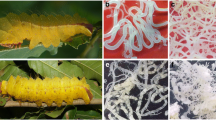Abstract
Nosema bombycis is a spore-forming parasite causing microsporidiosis in silkworm Bombyx mori. Methionine aminopeptidase 2 (MetAP2), an essential gene of N. bombycis, is a target for the anti-microsporidian drug Fumagillin, an antibiotic derived from Aspergillus fumigatus. In this study, a 1077 bp full-length cDNA of the MetAP2 gene of N. bombycis was cloned and characterized. Furthermore, the expression study of the MetAP2 gene revealed a ubiquitous expression during all the developmental stages of the silkworm B. mori. The phylogenetic analysis of the MetAP2 gene of N. bombycis revealed the MetAP2 gene sequences to be highly conserved in nature. The present study also includes the validation of the anti-microsporidian drug Fumagillin against the MetAP2 gene of N. bombycis. The findings revealed that Fumagilin-B could also suppress the N. bombycis multiplication in the silkworm B. mori, thereby proving the therapeutic role of Fumagillin against microsporidian infection. This is the first-ever report regarding the characterization of the MetAP2 gene in the Indian isolate of N. bombycis and also towards the usage of Fumagillin in the control of microsporidiosis in B. mori.





Similar content being viewed by others
References
Alvarado JJ, Nemkal A, Sauder JM, Roshell M, Akiyoshi DE, Shi W, Almo SE, Weiss LM (2009) Structure of a microsporidian methionine aminopeptidase type 2 complexed with Fumagillin and TNP-470. Mol Biochem Parasitol 168:158–167. https://doi.org/10.1016/j.molbiopara.2009.07.008
Didier PJ, Phillips JN, Kuebler DJ (2006) Anti microsporidial activities of Fumagillin, TNP-470, ovalicin, and ovalicin derivatives in vitro and in vivo. Antimicrob Agents Chemother 50:2146–2155. https://doi.org/10.1128/AAC.00020-06
Griffith EC, Su Z, Turk BE (1997) Methionine aminopeptidase (type 2) is the common target for angiogenesis inhibitors AGM-1470 and ovalicin. Chem Biol 4:461–471
Grob U (2003) Treatment of microsporidiosis including albendazole. Parasitol Res 90:14–18. https://doi.org/10.1007/s00436-002-0753
Higes M, Nozal MJ, Alvaro A, Barrios L, Meana A (2011) The stability and effectiveness of Fumagillin in controlling Nosema ceranae (microsporidia) infection in honey bees (Apis mellifera) under laboratory and field conditions. Apidologie 42:364–377. https://doi.org/10.1007/s13592-011-0003-2
Katinka MD, Duprat S, Cornillo E, Brottier P, Wincker P, Delbac F, Alaoui HE, Peyret P, Saurin W, Gouy M, Weissenbach J, Vivarès CP (2001) Genome sequence and gene compaction of the eukaryotic parasite Encephalitozoon cuniculi. Nature 184:29–42. https://doi.org/10.1038/35106579
Klein C, Folkers G (2003) Understanding the selectivity of Fumagillin for the methionine aminopeptidase type II. Oncol Res 13:513–520
Kumar S (2004) MEGA3: integrated software for molecular evolutionary genetics analysis and sequence alignment. Brief Bioinform 5(2):150–163
Liu S, Widom J, Kemp CW, Crews CM, Clardy J (1998) Structure of human methionine aminopeptidase-2 complexed with Fumagillin. Science 282:1324–1327
Lowther WT, McMillen DA, Orville AM, Matthews BW (1998) The anti-angiogenic agent Fumagillin covalently modifies a conserved active-site histidine in the Escherichia coli methionineaminopeptidase. Proc Natl Acad Sci 95:12153–12157. https://doi.org/10.1073/pnas.95.21.12153
Molina JM, Tourneur M, Sarfati C, Gouvello AD, Gobert JG, Balkan S, Deroin F (2002) Fumagillin treatment of intestinal microsporidiosis. N Engl J Med 346:1963–1969. https://doi.org/10.1056/NEJMoa012924
Pandrea I, Mittleider D, Brindley PJ, Didier E, Robertson D (2005) Phylogenetic relationships of methionine aminopeptidase 2 among Encephalitozoon species and genotypes of microsporidia. Mol Biochem Parasitol 140:141–152
Reddy DK, Nagaraju J, Abraham EG (1999) Genetic characterization of the silkworm Bombyx mori by simple sequence repeat (SSR)-anchored PCR. Heredity 83:681–687. https://doi.org/10.1046/j.1365-2540.1999.00607.x
Selvakumar T, Nataraju B, Chandrasekaran K, Sharma D (2005) Isolation of a new Microsporidian sp. (NIK-5hm) forming spores within the haemocytes of silkworm, B. mori L. Int J Ind Entomol 11:63–66
Stevanovic J, Simeunovic P, Gajic B, Lakic N, Radovic D, Fries I, Stanimirvoc Z (2013) Characteristics of Nosema ceranae infection in Serbian honey bee colonies. Apidologie 44:522–536
Turk BE, Su Z, Liu JL (1998) Synthetic analogues of TNP-470 and ovalicin reveal a common molecular basis for inhibition of angiogenesis and immunosuppression. Bioorg Med Chem 6:1163–1169. https://doi.org/10.1016/S0968-0896(98)00078-9
Van den Heever JP, Thompson TS, Curtis JM, Ibrahim A, Pernal SF (2014) Fumagillin: an overview of recent scientific advances and their significance for apiculture. J Agric Food Chem 62:2728–2737
Williams GR, Shutler D, Little CM, Maclellan KL, Rogers EL (2011) The microsporidian Nosema ceranae, the antibiotic Fumagilin-B, and Western honey bee (Apis mellifera) colony strength. Apidologie 42:15–22. https://doi.org/10.1051/apido/2010030
Zhang H, Huang H, Cali A, Takworian P, Feng X, Zhou G, Weiss L (2005) Investigations into microsporidian methionine aminopeptidase type 2: a therapeutic target for microsporidiosis. Folia Parasitol 52:182–192. https://doi.org/10.14411/fp.2005.023
Acknowledgements
The authors would like to thank Central Silk Board, Ministry of Textiles, Govt. of India, Bangalore, for providing the financial support and necessary facilities to carry out the research work and Dr. Ursula Da Rugna, Medivet Pharmaceuticals Ltd, High River, Canada, for the generous supply of Fumagilin-B for the research.
Author information
Authors and Affiliations
Corresponding author
Ethics declarations
Conflict of interest
The authors declare that they have no conflicts of interest.
Ethical approval
This article does not contain any studies with human participants or animals.
Electronic supplementary material
Below is the link to the electronic supplementary material.
13205_2018_1411_MOESM1_ESM.tif
Fig. S1 Schematic representation of primer-binding sites and PCR amplicon size of the MetAP2 gene of Nosema bombycis (TIF 117 KB)

13205_2018_1411_MOESM2_ESM.jpg
Fig. S2 Nosema bombycis MetAP2 gene expression in different developmental stages of silkworm, B. mori. The β-actin gene is used as an internal control. (JPG 44 KB)

13205_2018_1411_MOESM3_ESM.jpg
Fig. S3 Quantification of Nosema spore load in infected and Fumagillin-treated silkworms. The spore load was determined using qRT-PCR targeting the β-tubulin gene of Nosema bombycis using genomic DNA isolated from serially diluted spores. Data are expressed as relative-fold expression to the spore load of infected sample at 24 h post-infection, which defined as 1.0-fold. ***= P< 0.001. (Infected, Infected with Nosema bombycis; FT 2 mg, FT 20 mg, and FT 120 mg infected silkworms treated with Fumagillin at concentrations of 2 mg, 20 mg, and 120 mg, respectively) (JPG 172 KB)
Rights and permissions
About this article
Cite this article
Esvaran, V.G., Gupta, T., Nayaka, A.R.N. et al. Molecular characterization of Nosema bombycis methionine aminopeptidase 2 (MetAP2) gene and evaluation of anti-microsporidian activity of Fumagilin-B in silkworm Bombyx mori. 3 Biotech 8, 386 (2018). https://doi.org/10.1007/s13205-018-1411-z
Received:
Accepted:
Published:
DOI: https://doi.org/10.1007/s13205-018-1411-z




